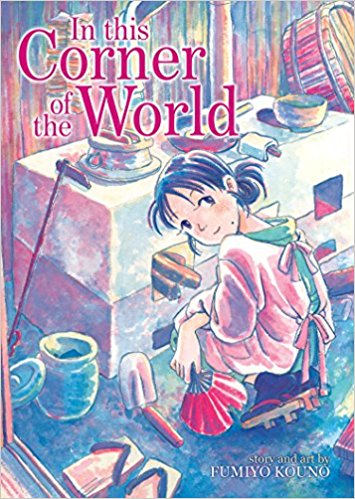By Fumiyo Kouno. Released in Japan as “Kono Sekai no Katasumi ni” by Futabasha, serialized in the magazine Manga Action. Released in North America by Seven Seas. Translated by Adrienne Beck.
Sometimes history can spoil a manga a bit. You know something is going to happen going in, simply given where and when the series takes place. That’s absolutely the case with the fantastic omnibus In This Corner of the World, which focuses on a young girl named Suzu, who’s a bit airheaded but good at art, and her coming of age and awkward but loving marriage to an uncommunicative husband. The manga, particular the first two-thirds, focuses on her everyday life as she does household chores, tries to find time to do some drawings, and deals with her sister-in-law’s ire, as Suzu is regarded by the sister-in-law as a bit too ditzy to be a good wife. Which, honestly, sometimes seems to be the case. The kicker here, of course, is that Suzu was born and grew up in Hiroshima, and moves to Kure when she gets married… right before World War II.
As such, there is a certain sense as you read though Suzu’s daily struggles that you’re waiting for the bomb to go off. And there is indeed a bomb, though Suzu does not deal first-hand with the Hiroshima H-bomb. No, it’s just a simple, ordinary bomb that kills her niece and blows off her right hand, the one she draws with. The last third or so of the book has a dazed and grieving Suzu try to come to terms with what’s happening and to try to patch things up with her husband (who was with a prostitute some time ago, which caused friction between them). Suzu is kind-hearted and gentle, though, and so aside from one burst of fury when Japan surrenders (which you can understand given everything she went through) she is able to move on with her life despite the new difficulties.
This is all conveyed through some absolutely gorgeous art, which does not hesitate to try a different style in order to get across the mood or the point that it wants to make. I’d even go so far as to call the art the main reason to buy the book, though the story is good as well. We see chapters done with no dialogue, as storybook-style, as a comic strip (Suzu’s childish drawings of her older brother, which becomes a breathtakingly bittersweet callback right at the end), as karuta art, and even as blurry, out–of-focus scenery as we see Suzu struggling with the loss of her dominant hand. The story is told via the art as well as the narrative, and the result is a volume that makes you want to go back and reread it after you’ve finished.
This is not an easy read, as you might expect, and there are moments of quiet tragedy that sometimes make it hard to move on. But I absolutely recommend it, as it’s an achingly gorgeous book that deserves all the hype it might get.

